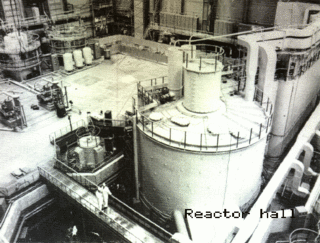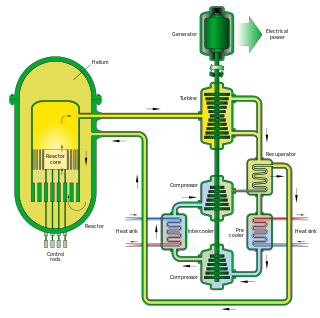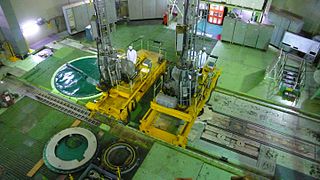Related Research Articles

A nuclear reactor is a device used to initiate and control a fission nuclear chain reaction or nuclear fusion reactions. Nuclear reactors are used at nuclear power plants for electricity generation and in nuclear marine propulsion. Heat from nuclear fission is passed to a working fluid, which in turn runs through steam turbines. These either drive a ship's propellers or turn electrical generators' shafts. Nuclear generated steam in principle can be used for industrial process heat or for district heating. Some reactors are used to produce isotopes for medical and industrial use, or for production of weapons-grade plutonium. As of 2022, the International Atomic Energy Agency reports there are 422 nuclear power reactors and 223 nuclear research reactors in operation around the world.
Mixed oxide fuel, commonly referred to as MOX fuel, is nuclear fuel that contains more than one oxide of fissile material, usually consisting of plutonium blended with natural uranium, reprocessed uranium, or depleted uranium. MOX fuel is an alternative to the low-enriched uranium fuel used in the light-water reactors that predominate nuclear power generation.

A breeder reactor is a nuclear reactor that generates more fissile material than it consumes. These reactors can be fueled with more-commonly available isotopes of uranium and thorium, such as uranium-238 and thorium-232, as opposed to the rare uranium-235 which is used in conventional reactors. These materials are called fertile materials since they can be bred into fuel by these breeder reactors.

Superphénix or SPX was a nuclear power station prototype on the Rhône river at Creys-Malville in France, close to the border with Switzerland. Superphénix was a 1,242 MWe fast breeder reactor with the twin goals of reprocessing nuclear fuel from France's line of conventional nuclear reactors, while also being an economical generator of power on its own. As of 2022, Superphénix remains the largest breeder reactor ever built.

A fast-neutron reactor (FNR) or fast-spectrum reactor or simply a fast reactor is a category of nuclear reactor in which the fission chain reaction is sustained by fast neutrons, as opposed to slow thermal neutrons used in thermal-neutron reactors. Such a fast reactor needs no neutron moderator, but requires fuel that is relatively rich in fissile material when compared to that required for a thermal-neutron reactor. Around 20 land based fast reactors have been built, accumulating over 400 reactor years of operation globally. The largest of this was the Superphénix Sodium cooled fast reactor in France that was designed to deliver 1,242 MWe. Fast reactors have been intensely studied since the 1950s, as they provide certain decisive advantages over the existing fleet of water cooled and water moderated reactors. These are:

The gas-cooled fast reactor (GFR) system is a nuclear reactor design which is currently in development. Classed as a Generation IV reactor, it features a fast-neutron spectrum and closed fuel cycle for efficient conversion of fertile uranium and management of actinides. The reference reactor design is a helium-cooled system operating with an outlet temperature of 850 °C (1,560 °F) using a direct Brayton closed-cycle gas turbine for high thermal efficiency. Several fuel forms are being considered for their potential to operate at very high temperatures and to ensure an excellent retention of fission products: composite ceramic fuel, advanced fuel particles, or ceramic clad elements of actinide compounds. Core configurations are being considered based on pin- or plate-based fuel assemblies or prismatic blocks, which allows for better coolant circulation than traditional fuel assemblies.

Madras Atomic Power Station (MAPS) located at Kalpakkam about 80 kilometres (50 mi) south of Chennai, India, is a comprehensive nuclear power production, fuel reprocessing, and waste treatment facility that includes plutonium fuel fabrication for fast breeder reactors (FBRs). It is also India's first fully indigenously constructed nuclear power station, with two units each generating 220 MW of electricity. The first and second units of the station went critical in 1983 and 1985, respectively. The station has reactors housed in a reactor building with double shell containment improving protection also in the case of a loss-of-coolant accident. An Interim Storage Facility (ISF) is also located in Kalpakkam.

The BN-600 reactor is a sodium-cooled fast breeder reactor, built at the Beloyarsk Nuclear Power Station, in Zarechny, Sverdlovsk Oblast, Russia. It has a 600 MWe gross capacity and a 560 MWe net capacity, dispatched o the Middle Urals power grid. It has been in operation since 1980 and represents an evolution on the preceding BN-350 reactor. In 2014, its larger sister reactor, the BN-800 reactor began operation.

The Beloyarsk Nuclear Power Station was the third of the Soviet Union's nuclear plants. It is situated by Zarechny in Sverdlovsk Oblast, Russia. Zarechny township was created to service the station, which is named after the Beloyarsky District. The closest city is Yekaterinburg.
A liquid metal cooled nuclear reactor, or LMR is a type of nuclear reactor where the primary coolant is a liquid metal. Liquid metal cooled reactors were first adapted for breeder reactor power generation. They have also been used to power nuclear submarines.

The SNR-300 was a fast breeder sodium-cooled nuclear reactor built near the town of Kalkar, North Rhine-Westphalia, Germany. The reactor was completed but never taken online. SNR-300 was to output 327 megawatts. The project cost about 7 billion Deutsche Mark. The site is now the location of a theme park, Wunderland Kalkar, which incorporates much of the power plant buildings into the scenery.

The Clinch River Breeder Reactor Project was a nuclear reactor project that aimed to build the USA's first large-scale demonstration breeder reactor plant. It was led by the U.S. Atomic Energy Commission. The project was opposed by President Carter.
Reactor-grade plutonium (RGPu) is the isotopic grade of plutonium that is found in spent nuclear fuel after the uranium-235 primary fuel that a nuclear power reactor uses has burnt up. The uranium-238 from which most of the plutonium isotopes derive by neutron capture is found along with the U-235 in the low enriched uranium fuel of civilian reactors.

China is one of the world's largest producers of nuclear power. The country ranks third in the world both in total nuclear power capacity installed and electricity generated, accounting for around one tenth of global nuclear power generated. As of February 2023, China has 55 plants with 57GW in operation, 22 under construction with 24 GW and more than 70 planned with 88GW. About 5% of electricity in the country is due to nuclear energy. These plants generated 417 TWh of electricity in 2022 This is versus the September 2022 numbers of 53 nuclear reactors, with a total capacity of 55.6 gigawatt (GW). In 2019, nuclear power had contributed 4.9% of the total Chinese electricity production, with 348.1 TWh.

The Pakistan Atomic Research Reactor or (PARR) are two nuclear research reactors and two other experimental neutron sources located in the PINSTECH Laboratory, Nilore, Islamabad, Pakistan.
The BN-800 reactor is a sodium-cooled fast breeder reactor, built at the Beloyarsk Nuclear Power Station, in Zarechny, Sverdlovsk Oblast, Russia. The reactor is designed to generate 880 MW of electrical power. The plant was considered part of the weapons-grade Plutonium Management and Disposition Agreement signed between the United States and Russia, with the reactor being part of the final step for a plutonium-burner core The plant reached its full power production in August 2016. According to Russian business journal Kommersant, the BN-800 project cost 140.6 billion rubles.

The BN-1200 reactor is a sodium-cooled fast breeder reactor project, under development by OKBM Afrikantov in Zarechny, Russia. The BN-1200 is based on the earlier BN-600 and especially BN-800, with which it shares a number of features. The reactor's name comes from its electrical output, nominally 1220 MWe.
ETRR-2 or ET-RR-2, or is the second nuclear reactor in Egypt supplied by the Argentine company Investigacion Aplicada (INVAP) in 1992. The reactor is owned and operated by Egyptian Atomic Energy Authority (EAEA) at the Nuclear Research Center in Inshas, 60 kilometres (37 mi) northeast of Cairo.
The BREST reactor is a Russian concept of lead-cooled fast reactor aiming to the standards of a generation IV reactor. Two designs are planned, the BREST-300 and the BREST-1200. Main characteristics of the BREST reactor are passive safety and a closed fuel cycle.
The utilization of nuclear power in Kazakhstan began with Kazakhstan's first nuclear power plant, the BN-350 fast-neutron reactor in Aktau, operating from 1973 to 1999, a Soviet era prototype investment preceding the BN-600 reactor. Since then, it has only operated four smaller research reactors and did not have nuclear electricity production capabilities. Kazakhstan is the number one country in the world for uranium production volumes, which is used for nuclear fuel. Current plans, reaching back to 1997, foresee the construction of two new nuclear power plants near the towns of Ulken and Kurchatov.
References
- 1 2 "CFR-600 (China Institute of Atomic Energy, China)" (PDF). IAEA. Retrieved 16 January 2018.
- 1 2 3 4 "China begins building pilot fast reactor". www.world-nuclear-news.org. Retrieved 16 January 2018.
- 1 2 3 4 Patel, Prachi (28 Dec 2022). "China's New Breeder Reactors May Produce More Than Just Watts". IEEE Spectrum.
- 1 2 "China starts building second CFR-600 fast reactor". www.world-nuclear-news.org. Retrieved 29 December 2020.
- ↑ CCCC-FHDI wins bid for quot;feasibility study of offshore engineering of 600MW fast reactor nuclear power demonstration project in Xiapu , 12.03.2015. (Archived Version on archive.is).
- 1 2 "PRIS - Reactor Details". pris.iaea.org. Retrieved 2022-07-28.
- ↑ "Concerns grow over China nuclear reactors shrouded in mystery". Al Jazeera. 19 May 2021.